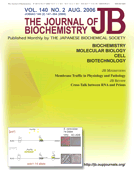-
Views
-
Cite
Cite
Jieru Meng, Nan Ma, Zhen Yan, Wei Han, Yingqi Zhang, NGR Enhanced the Anti-Angiogenic Activity of tum-5, The Journal of Biochemistry, Volume 140, Issue 2, August 2006, Pages 299–304, https://doi.org/10.1093/jb/mvj152
Close - Share Icon Share
Abstract
Tumstatin is an angiogenesis inhibitor. The anti-angiogenic activity of tumstatin is localized to the 54–132 amino acids. NGR motif is a marker of angiogenic endothelial cells. We synthesized the gene fragment encoding the amino acids 45–132 of tumstatin (tum-5) and coupled a NGR (CNGRCVSGCAGRC) motif to the C-terminal of tum-5 (tum-5-NGR). The both were inserted into pQE30 expression vector and expressed in Escherichia coli. The anti-angiogenic effects of tum-5-NGR and tum-5 were examined in vivo. The results demonstrated the effect of the former was more significant than the latter. After S180 murine cancer xenografts in BALB/c mice were treated with tum-5-NGR or tum-5, tum-5-NGR displayed more significant tumor growth inhibition than tum-5. Binding of tum-5-NGR to normal and tumor tissues was also evaluated. The results showed that the accumulation of tum-5-NGR in tumor tissue was much more than in normal tissues. These data suggest that NGR enhance the anti-angiogenic activity of tum-5.





